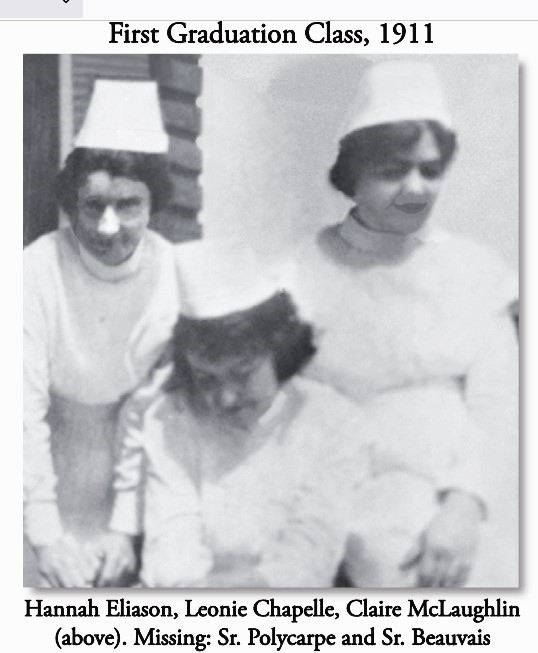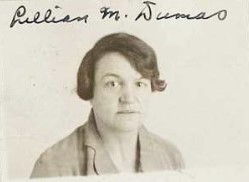This is the 21st in a series of columns about the 70 British Home Children sent to St. Patrick’s Catholic Orphanage in Prince Albert between 1901 and 1907. While all orphanage records were destroyed in the terrible fire of 1947, every attempt has been made to trace the life stories of these dispossessed children through genealogy websites and newspaper databases.
Two Who Became Nurses
“When I was five years old I was brought out to Canada from England, with a ticket pinned to my coat, and with the resolve already in my childish heart that someday I would make a place myself in the great, cold world where I could help others as the kind nurses had helped me.”
– Cecilia Jewett, British Home Child who became a nurse, from her book No Thought for Tomorrow (1955)
Under the British Child Migrant scheme, the Catholic Emigration Society, the organisation that had entered into the agreement with the government to look after the 70 children sent to Prince Albert, were responsible for helping them to access employment once they were old enough to leave St. Patrick’s orphanage. Most of the boys became farmers. On leaving the institution, many of the young women became nuns or found employment in traditionally female dominated professions such as nursing and teaching – until marriage and motherhood removed them from the work force.
Here are the stories of two of the British Home girls from Prince Albert who entered the nursing profession.
Charlotte May McLaughlin (1891-1939)
On November 21, 1909, 18-year-old Charlotte McLaughlin was the first student admitted to the newly established School of Nursing at St. Paul’s Hospital in Saskatoon. Four others, including Hannah Eliason, Leonne Lachappelle, and two Grey Nuns, Sister Beauvais and Sister Polycarp, arrived shortly afterwards. St. Paul’s Hospital was established in 1907 and the School of Nursing two years later.
Born in Cape Town, South Africa on 5 August 1891 to Irish parents, bootmaker Patrick McLaughlin (abt 1843-) and Elizabeth (Stone) McLaughlin (1868-1898), Charlotte and her two brothers William Patrick (1893-1917) and Bertram Alexander (1897-1967) were all shipped to Canada from England as British Home Children, but not together. Charlotte was the only one of the three sent to St. Patrick’s Catholic Orphanage in Prince Albert; she arrived at age 11 in May 1903. After she completed Grade 8, she likely moved on to Sion Academy before heading to Saskatoon to study nursing.

St. Paul’s Hospital, struggling to care for numerous cases of typhoid each year, welcomed Charlotte and the other four nursing students with open arms. “At last, we will have some help!” wrote one of the Grey Nuns in the hospital Chronicles on 21 November 1909. “[W]e will have nursing students who, under our direction will follow a course of training and studies during two and a half years.” The School of Nursing was open to women between the ages of 18 and 30 “who in the opinion of the Sisters, join to a good education, and aptitude and a vocation for the very arduous work of sick nursing.” At six feet tall and weighing 164 pounds, Charlotte was a strong candidate for the rigors of nursing.
According to the book, St. Paul’s School of Nursing Alumni: Looking Back One Hundred Years (2011), bedside procedures were taught by the supervisor and senior nurses. Doctors lectured on fundamental subjects and the Director of Nurses, Sister Marie-du-Saint-Sacrament, taught classes related to the doctor’s lectures.
I contacted the Grey Nuns Archives in Montreal and learned that unfortunately they do not have records for the nursing program before 1925 nor any student files. They did, however, send me an excerpt from the Students’ Examination Book, St. Paul’s Hospital, Saskatoon, 1910-1929 (L070/G,3) which shows Charlotte’s courses and exam marks for 1910 and 1911, as follows:
– Anatomy & Physiology = 85%
– Surgery = 79% written; 50% practical and oral
– Hygiene = 69%
– Gynecology = 89%
– General Practice = 66%
– Materia Medica (Pharmacology) = 85%
– Diseases of Infancy and Childhood = 76%
– Ophthalmology = 75%
– Infectious Diseases = 80%
– Obstetrics = 80%
The School of Nursing Alumni’s book states that the student nurses’ residence was the third-floor attic of the hospital; their classroom was in the same third-floor attic. “Each student was given free room and board along with a stipend: $5.00 per month in the first year and $10.00 in the second. The uniform … consisted of a below-the-calf basic blue dress, white clerical collar, bib, apron and cuffs, a white cap and black button boots.” When Charlotte and the other four nursing students graduated on 21 September 1911, the basic blue dress was replaced by a basic white dress, but other items of the uniform remained the same.
After she graduated, Charlotte worked as a nurse in Saskatoon for several years. When the United States entered the First World War in April 1917, she travelled to St. Paul, Minnesota at age 26 to work as a Training Nurse, likely under the auspices of the American Red Cross.
After the war, Charlotte returned to Saskatoon for a short time before moving to San Francisco, California in 1920 where she lived for the rest of her life. She never married. Charlotte became an American citizen on 3 January 1927. After a career as a registered nurse at the University of California Hospital, she died at age 48 on 25 August 1939 and is buried at Holy Cross Cemetery in San Francisco.
Lillian Mary Dumas (1893 – 1986)
Lillian Dumas often recorded on various documents that she was born in France or that she was of French heritage, but she was born at Berwick-upon-Tweed, Northumberland, England on 7 August 1893 to Irish parents.
Her older brothers William and Benedict had both been born in Bengal, India where her father Adolphus Dumas (1858 – 1932) served as a sergeant in the British Army. Adolphus’ military career ended badly. He was discharged at age 36 from 1st Battalion King’s Own Scottish Borderers in October 1895, with his character rated as “Fair” (most were Good or Very Good). In February 1896 he was tried in York for being drunk on duty the previous year.
Lillian’s mother Bridget (Nolan) Dumas died in 1901 at age 34. Adolphus sent his three children to children’s homes. In 1902, he remarried and had six more children. That year, Lillian’s brothers William (age 11) and Benedict (age 9) were sent to St. Vincent House, Montreal by the Liverpool Catholic Children’s Protection Society. After living at Bexhill Nazareth House – a home for orphan and destitute Catholic girls – for several years, 10-year-old Lillian was shipped by the Catholic Emigration Society to St. Joseph’s Catholic Orphanage in Prince Albert in October 1903. The 1911 Canada census shows “Lilly” was still living in the orphanage at age 17.
Lillian’s grand niece, Marylee O’Neill recently messaged me with the following information: “The family story goes that as soon as my grandfather [William Dumas] was old enough and had saved funds, he went to get my aunt Lillian, who had become a nun after the orphanage, and arranged for her to leave the convent – I guess a scandal at that time.” (Marylee has more information about Lillian that she plans to scan and send to me. I will publish an update about her in a future column.)
Lillian must have studied nursing in Toronto, perhaps at the University of Toronto. I have not yet found any record of her at nursing school.
In 1920, Lillian moved permanently to Detroit, Michigan where she began her nursing career, first as a private nurse and later as an industrial nurse. She applied for US citizenship on 18 August 1930, stating that her race was French. Thomas M. Rowling, a builder who she later married, provided an affidavit for her application. Her naturalization was not granted until 1935.
The US census for 1950 shows Lillian, age 56 and still single, working as a registered industrial nurse at a steel factory in Detroit. She gave her birthplace as France in that census.
Industrial nurses often worked alone, giving first aid to the ill and injured, preparing accident reports, and delivering health education and accident prevention programs. Night shifts were a requirement. Mary Louise Brown, in her 1988 presentation on the 100-year history of industrial or occupational health nursing in the United States, observed that the most characteristic feature of industrial nursing was the loneliness of the one-nurse position. The industrial nurse had “to be a self-starter, creative and competent,” she stated. “These one-nurse positions provide the nurse with no role model and no one with whom to confer.”
Sometime between 1950 and 1973 Lillian married Thomas M. Rowling (1886-1977). He must have been quite elderly; he was 91 years old when he passed away in 1977. Lillian died on 19 June 1986 in Detroit at age 93.


